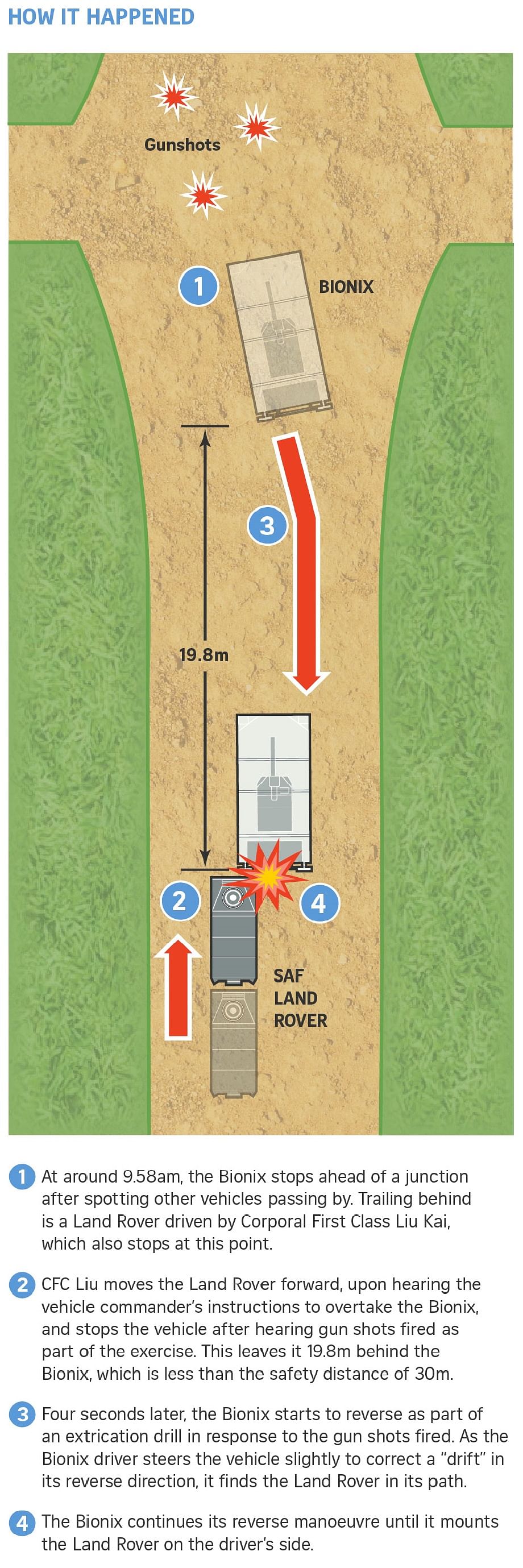Wild Ride From a Land Rover to a Bionix — The Tragic Turn of a Training Exercise
When a routine drill takes a deadly turn: 22‑year‑old CFC Liu Kai was killed on a Singapore training field when a Land Rover collided with a Bionix armoured vehicle. The man behind the wheel, Captain Ong Lin Jie, claimed (and was accused) of being careless, and he has pleaded not guilty.
What Went Down
- November 2018, a two‑company exercise ran through a T‑junction on the 42nd Battalion’s field.
- Ong was there to watch the “opposition force” and to make sure the safety rules were followed.
- He ordered Liu to overtake a Bionix that had just stopped outright up front of the junction.
- Because the Land Rover didn’t keep the required 30 m buffer, it got slammed into by the Bionix when the vehicle reversed in a drill.
- Liu died of traumatic asphyxiation – the collision knocked him out of the car.
Legal Fallout
Ong is now on suspended leave, awaiting his court date. The charges carry up to five years in jail, a fine, or both.
Prosecution’s Argument
Deputy public prosecutors argue that Ong knew the Bionix could reverse at any time, and that failing to maintain a safe gap and to confirm permission before overtaking was flagrant negligence.
Defence’s Counterpoint
Ong’s lawyer, Mr Teo Choo Kee, asserts there’s no regulation enforcing a pre‑overtake call‑out. He points to the standard practice of keeping a 2 m gap whenever a vehicle passes a stationary armoured unit, and records that the commanding officer would have honked to signal his intent.
Testimony Highlights
- Captain Wan Hong Wee— the exercise commander— said that overtaking an unmoving Bionix “usually means keeping a few metres apart.”
- He noted no formal requirement for waving to the crew before moving past.
- He admitted he would have shone his horn if he had been the one on duty.
Next Steps
The trial is still to come on Friday; the jury will decide whether Captain Ong’s decision was a reckless shortcut or simply a misstep in a chaotic environment.
Stay tuned for more updates on this tragic incident that reminds us even training grounds can become deadly roads.

When the Singapore Army Pulls a Rash Move Court Drama Unfolds
Picture this: a squad of Singapore’s finest troops, marching in perfect formation worldwide, suddenly brandishing a “rash” move that caught everyone off guard. And guess what? The very same act drummed itself into the courtroom.
What Happened?
During a routine parade, officials decided to outsource their uniform production to a foreign supplier, believing it would cut costs. Someone in the planning team, thinking “why not?” — in hindsight, we’d call it the “rash act” that busied the entire supply chain. The switch sent shockwaves through military logistics, unexpectedly straining the Army’s operational readiness.
Why the Court Came into the Picture
- Contractual Quagmire: The original contractor wasn’t happy with the sudden switch, claiming breach of contract.
- Safety Concerns: New uniforms didn’t meet the established safety specs, causing two minor injuries at a training exercise.
- Communication Slip‑Up: Multi‑level bureaucracy failed to keep all stakeholders in the loop, prompting an audit.
The Court’s Take
In a flurry of legal filings, lawyers argued that the rapid decision violated procurement guidelines and breached statutory duties of public service. The court, after a whirlwind of paperwork, issued a temporary injunction to halt the rollout of the new kit while a full assessment is made.
Key Takeaways
- Better to think before you act—especially when it involves the military.
- Transparency isn’t optional; it’s a safeguard that keeps everyone on the right side of the law.
- A single rash decision can cause a domino effect that even gets the courts involved.
So, What Do You Think?
Invite you to reflect: Should bureaucracy prioritize safety over speed? Perhaps the lesson here is that swift moves might look smart in the moment but be a costly blind spot later on. Let us know your thoughts in the comments—after all, no one immune to the humor of a bureaucratic mishap!
Disclaimer: This rewrite is a creative, fictional illustration for educational purposes, inspired by snippets from a Straits Times article.




